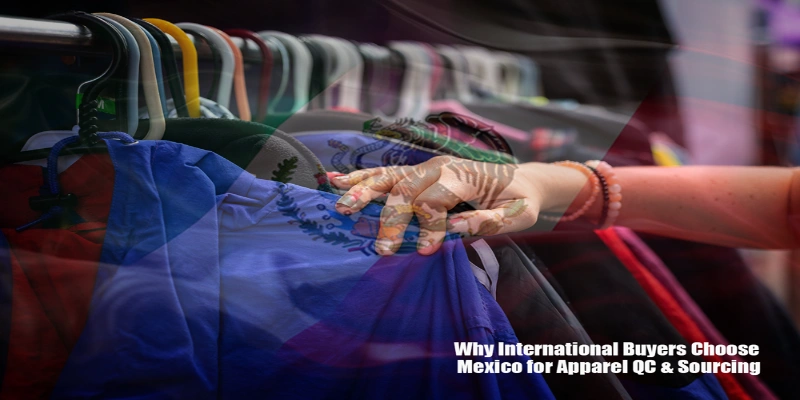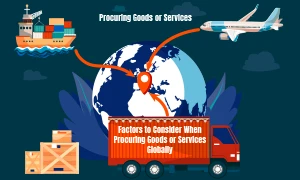
Mexico’s strategic location, USMCA trade benefits, and strong manufacturing capabilities make it a top choice for apparel buyers seeking speed, cost efficiency, and supply chain stability. This advantage is reflected in trade trends, as imports from Mexico to the U.S. grew at an average of 6% annually between 2020 and 2024, highlighting its rising importance in regional apparel sourcing.
Mexico is now a preferred destination for fashion brands focused on faster delivery, reliable QC, and tariff benefits. This comprehensive, data-driven guide explores why Mexico has become a preferred destination for apparel sourcing and outlines practical strategies for building an effective, high-performing QC program on the ground.
Why Mexico Stands Out for International Apparel Buyers
Mexico stands out for international apparel buyers due to a combination of factors, including:
1. Trade and Proximity Advantages
Mexico has become a strategic hub for apparel buyers thanks to its location, logistics, and trade benefits.
- Top U.S. Import Partner
In 2023, the U.S. imported more goods from Mexico than from China for the first time in two decades, strengthening Mexico’s role in North American supply chains. - Faster, Over-the-Road Delivery
Typical road transit from central Mexico to U.S. distribution centers is measured in days, not weeks, with roughly 2 to 3 days to Dallas and 4 to 5 days to New York. This shortens lead times and enables faster replenishment cycles. - Busiest U.S. Trade Gateway
Port Laredo (TX) is now the #1 U.S. port for international trade, serving as a logistics super-corridor for major retail and apparel networks.
Why It Matters: Shorter transit means less inventory holding, faster corrective actions when QC issues arise, and lower freight risk compared to long ocean lanes from Asia.
2. USMCA Duty Savings
The U.S.–Mexico–Canada Agreement (USMCA) offers duty-free access for qualifying textile and apparel products under the “yarn-forward” rules of origin (ROO), which require spinning, fabric formation, and garment assembly to occur within North America.
Pro Tip:
Pre-clear ROO eligibility with your customs broker and map your fiber → yarn → fabric → cut-and-sew chain. Using non-originating materials (e.g., Asian fabrics) can disqualify shipments from duty-free benefits.
3. Quality Control Environment and Faster Corrective Loops
Mexico’s nearshoring advantage allows for tighter QC oversight and faster response times.
- Rapid QC Cadence
With truck lead times of 2 to 7 days, your team or inspectors can perform inline inspections (DUPRO), request corrections, and re-inspect within the same week, which is much faster than ocean-based supply chains. - Standardized QC Methods
Mexico’s factories commonly follow AQL/ISO 2859-1 sampling frameworks, the same global QC standards used in China, Vietnam, and India, ensuring consistency across regions. - Robust Border Infrastructure
High-volume crossings via Laredo/Nuevo Laredo and ongoing customs modernization improve clearance times and make just-in-time deliveries more reliable.
4. Strong Manufacturing Capabilities
Mexico offers deep industrial expertise in apparel production, making it highly competitive for U.S. and global buyers.
- Core Strengths: Denim, casualwear, uniforms, athleisure, knitwear, and fast-turn basics.
- Production Hubs: Historic garment clusters in Puebla, Tlaxcala, and Yucatán provide skilled labor, established supplier bases, and scalable capacity.
- Best-Fit Programs: Near-border, quick-turn replenishment models work exceptionally well for U.S. brands.
5. Programs That Streamline Manufacturing
The IMMEX (maquiladora) program allows certified manufacturers to temporarily import inputs duty-free and VAT-free and re-export finished goods, enabling cost-efficient cross-border manufacturing models.
Additionally, VAT/IEPS certification can further defer VAT on temporary imports, improving cash flow and operational efficiency.
6. Compliance and Labor Standards
Under USMCA, Mexico has strengthened labor protections through an enforceable labor chapter and the Rapid Response Labor Mechanism (RRM), which addresses labor disputes at the facility level.
For international buyers, this shift aligns apparel sourcing with ESG standards and social compliance goals, making Mexico an attractive nearshoring destination for brands focused on sustainability.
7. The Nearshoring Advantage: Time and Cost Savings
Nearshoring to Mexico provides apparel buyers with several key advantages. These include:
- Shorter Lead Times
Road transit to the U.S. takes just a few days compared to 3 to 6 weeks by sea from Asia, reducing stockouts and enabling faster product cycles. - Duty-Free Benefits
USMCA-qualified apparel ships tariff-free, while China-origin items often face Section 301 tariffs, creating a clear cost advantage. - Supply Chain Resilience
Nearshoring diversifies supply away from long, volatile ocean lanes and reduces exposure to political tariff risks and logistical disruptions.
What Can Mexico Not (Yet) Solve?
Mexico offers significant advantages for apparel sourcing, including faster lead times, strong quality control frameworks, and USMCA trade benefits, but it is important for international buyers to understand the current limitations. Planning around these gaps ensures smoother supply chain execution and helps avoid unexpected challenges.
1. Limited Capacity for Certain Product Categories
Mexico has strong capabilities in denim, casualwear, uniforms, athleisure, and fast-turn basics, but it is less competitive in highly specialized or technical apparel categories, such as:
- High-performance sportswear including moisture-wicking, compression, or thermal gear
- Luxury fashion requiring niche craftsmanship
- Technical outerwear with advanced seam-sealing, lamination, or specialty coatings
For these categories, Asia, especially China, Vietnam, and Bangladesh, still offers broader expertise and larger-scale production networks.
2. Dependency on Imported Raw Materials
Mexico’s apparel industry has grown rapidly, but domestic textile production is still limited for certain fabrics, trims, and specialty inputs.
- Brands often import raw materials such as performance fabrics, zippers, and elastics from Asia or Europe.
- This dependency can extend lead times and complicate USMCA compliance, since non-originating materials may disqualify products from duty-free benefits.
3. Complexity of USMCA Rules of Origin
While USMCA provides major tariff advantages, its “yarn-forward” rule creates compliance challenges:
- All major stages, including spinning, fabric formation, and garment assembly, must occur within North America.
- Using non-originating fabrics or trims risks losing duty-free eligibility.
For companies working with hybrid sourcing strategies, careful supply chain mapping is essential to avoid unexpected costs.
4. Regional Infrastructure Gaps
Although Mexico has strong manufacturing clusters, infrastructure challenges remain in some regions:
- Port congestion in certain areas during peak seasons
- Highway bottlenecks in regions with heavy cross-border trade
- Variability in warehouse automation, technology integration, and distribution facilities
These gaps do not prevent effective sourcing but require careful logistics planning and partnerships with experienced freight forwarders.
5. Labor Dynamics and Training Needs
Mexico’s workforce is skilled in denim, basics, and mid-level garment construction, but scaling rapidly for high-volume, high-complexity production poses challenges:
- Some factories require upskilling programs to adopt advanced automation, digital pattern-making, or sustainable production practices.
- Rising labor demand in industrial hubs may gradually increase wage pressures, affecting long-term cost competitiveness.
6. Limited Ecosystem for High-End Innovation
Compared to China and Vietnam, Mexico has fewer R&D hubs for:
- Smart textiles and wearable technology
- Advanced sustainable fibers
- High-performance technical materials
Brands focusing on innovation-heavy apparel may still need to rely on Asia-based partners for early-stage development.
With apparel sourcing from Mexico on the rise, ensuring effective quality control is essential for consistent production and buyer satisfaction. Learn more in our detailed guide on Why Apparel Quality Control is Critical When Sourcing in Mexico.
How Can Apparel Buyers Build an Effective QC Strategy?
To fully leverage Mexico’s strengths in apparel sourcing, international buyers need a structured quality control (QC) strategy. With shorter lead times and global-standard QC frameworks, Mexico allows buyers to implement tighter oversight and faster corrective measures compared to long-distance sourcing from Asia.
Below is a detailed five-step QC framework tailored for apparel brands sourcing from Mexico:
1. Start with Pre-Production Checks
Before production begins, ensure that all technical specifications and standards are clearly defined and communicated to your manufacturing partner.
- Finalize Tech Packs: Provide detailed documents covering product designs, size specs, materials, trims, stitching, labeling, and finishing details.
- Approve Size Sets: Review samples for every size variant to confirm fit, comfort, and measurement accuracy.
- Set Fabric and Trim Standards: Test fabrics and trims for color consistency, GSM (grams per square meter), shrinkage, durability, and hand feel.
- Define QC Tolerances: Establish acceptable variances for measurements, seams, and stitching to avoid ambiguity during inspections.
Why it matters: A strong pre-production process minimizes miscommunication and prevents costly errors later in the production cycle.
2. Use Inline DUPRO Inspections
During Production (DUPRO) inspections are essential for catching defects early and preventing mass quality failures.
- Conduct mid-line inspections once 20–30% of production is complete.
- Check for stitching consistency, seam strength, fabric defects, and labeling accuracy.
- Review workmanship quality against approved samples and technical specifications.
- Communicate issues immediately so factories can correct them without halting production.
Why it matters: Inline inspections allow faster corrective action, reducing rework costs and keeping deliveries on schedule, which is a major advantage when sourcing from Mexico due to shorter transit times.
3. Apply AQL Sampling Standards
Acceptance Quality Limit (AQL) inspections ensure product quality is consistent across suppliers and production runs.
- Use ISO 2859-1 / ANSI Z1.4 sampling frameworks for standardized inspections.
- Choose the right AQL levels depending on defect severity:
- Critical Defects (AQL 0.0): Product unusable or unsafe
- Major Defects (AQL 2.5): Visible issues affecting usability or aesthetics
- Minor Defects (AQL 4.0): Small cosmetic flaws that do not affect function
- Randomly select garments from different lots, colors, and sizes for unbiased inspections.
Why it matters: AQL sampling ensures uniform quality across suppliers while maintaining efficiency by avoiding 100% inspections.
4. Integrate Returns and Defect Data
Your QC strategy should go beyond factory inspections by analyzing real-world performance data from returns and customer feedback.
- Track customer complaints and categorize them by defect type (e.g., sizing issues, seam failures, color fading).
- Share defect patterns with suppliers to improve future production quality.
- Use insights to update tech packs, QC tolerances, and material selections.
- Align your suppliers with KPIs (e.g., “First Pass Yield” or “Defect Rate per 1,000 units”) for better accountability.
Why it matters: Closing the feedback loop ensures your QC process continuously improves and leads to long-term product reliability.
5. Schedule Regular Audits and ESG Compliance Checks
Beyond product inspections, regular factory audits are critical for ensuring consistent quality and social compliance.
- Process Audits: Check manufacturing efficiency, equipment reliability, and operator training levels.
- Quality System Audits: Evaluate adherence to ISO 9001 and other quality management standards.
- ESG Compliance Audits: Assess labor conditions, worker safety, and environmental sustainability, ensuring alignment with USMCA labor rules and brand ESG commitments.
Why it matters: Regular audits build trust with suppliers, strengthen brand credibility, and ensure your sourcing strategy meets both quality and sustainability goals.
Selecting the right quality control partner is key to maintaining high production standards and avoiding costly errors. For a detailed guide, explore our article on How to Choose the Right QC Partner for Garment Sourcing in Mexico.
SIXM: Your Trusted Partner for Apparel QC and Sourcing in Mexico
Mexico has become a strategic hub for international apparel buyers, offering faster lead times, stronger quality control, and cost-efficient sourcing under USMCA. At SIXM, we are trusted Procurement & Sourcing Specialists, helping global brands streamline their sourcing strategies, implement robust QC frameworks, and build resilient supply chains in Mexico.
Partner with SIXM to unlock smarter, faster, and more reliable apparel sourcing solutions.

